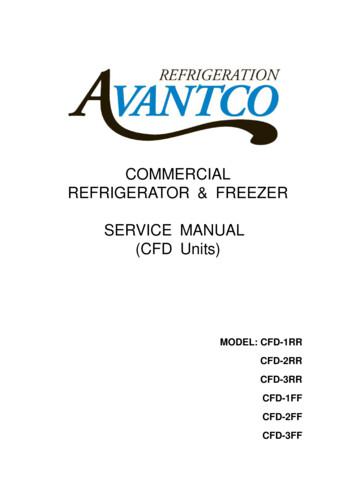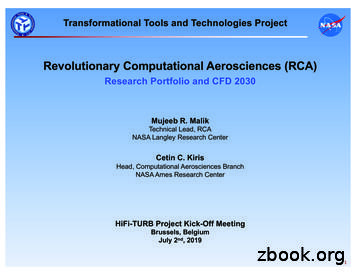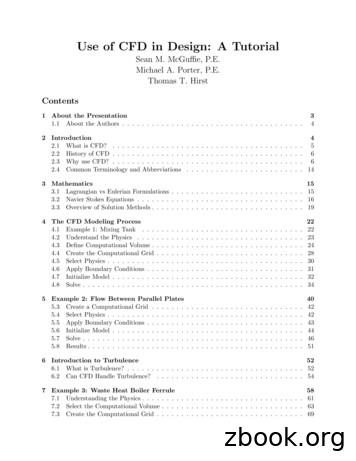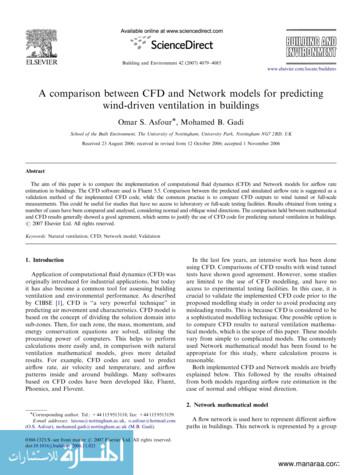CFD Analysis Process - NASA
Glenn Research CenterCFD Analysis Process1
CFD Analysis ProcessGlenn Research Center1.2.3.4.5.6.7.8.9.10.11.Formulate the Flow ProblemModel the GeometryModel the Flow (Computational) DomainGenerate the GridSpecify the Boundary ConditionsSpecify the Initial ConditionsSet up the CFD SimulationConduct the CFD SimulationExamine and Process the CFD ResultsFurther Analysis?Report the FindingsThe objective is confidence that the CFD results provide accurate,credible, and useful information.2
1) Formulate the Flow ProblemGlenn Research CenterDetermine the following:1.What is the objective?Engineering quantitiesPerformanceProof of concept2.What is known?Freestream conditionsGeometryConfiguration3.What analysis approach to use?Steady or unsteady flow?Are viscous forces important?Are shocks present?What equations to solve?What other flow models are needed?ONERA M6 Wing- Section coordinates and wing tip shape- Tunnel test section: M, Re, Tt- Wing: α- Aerodynamics quantities to determine:Static pressure distributions (loading)Lift and drag coefficients3
2) Model the GeometryGlenn Research CenterDetermine the following:1.What geometric features are significant?Steps, leading edges, trailing edges2.Any simplification of the geometry needed?Smooth over small steps3.What computational format for geometry?Lines, curves, surfacesCAD file format (IGES, Step, )ONERA M6 Wing- Table of airfoil coordinates- Drawing of planform shape- Develop a CAD model of wing4
3) Model the Flow DomainGlenn Research CenterThe flow (computational) domain is thecontrol volume (bounded by the controlsurface) in which the flow field is computed. Body is part of surface of flow domain.The geometry of the flow domain is alsocomputationally modeled (CAD).Shape of the flow domain usually considersthe grid topology (this is especially true ofstructured grids).Extent of flow domain depends on choice ofboundary conditions.-Subsonic flow boundaries need to be farther outsince waves travel in all directions.Supersonic flow boundaries can be closer tobody if one considers wave motion.Reflection (flow symmetry) planes caneffectively reduce the size of the flow domain.WingReflectionPlaneOutflowFarfieldONERA M6 Wing- Wing surface part of domain boundary- Reflection plane at root of wing- Farfield boundaries out 15 chord lengths- Outflow boundary downstream5
4) Generate the GridGlenn Research CenterA grid is generated within the flow domain. The grid consists of finite-volume cells onwhich the CFD equations are approximated.The flow domain may be divided into zonesfor various reasons:- Simplify grid generation.Reduce memory requirements.Divide grid for parallel computation.Grids can be structured or unstructured.Software packages are available for gridgeneration: Gridgen, ICEM CFD, VGRID.ONERA M6 Wing- Single-zone C-grid wrapped about the wing- Cluster grid normal to wall (y 30)- Clustering downstream helps resolve wake- Stretch grid away from wing (15-20%)6
5) Specify the Boundary ConditionsGlenn Research CenterNumerical conditions need to be appliedat the boundaries of the flow domainand zones. Specify types of boundary condition:Viscous Wall BCReflection BCOutflow BCViscous (no-slip) wallInflow / outflowReflectionCoupled Zone-to-zone boundaries and overlappedzones require topology and couplingspecifications.Freestream BC Specification of boundary conditions may be ONERA M6 Wingpart of grid generation package.- Freestream BC at farfield boundary Additional inputs may be required in theflow code input process (i.e. flow rates,pressures, ).- Outflow BC at outflow boundary- No-slip, adiabatic wall BC at wing surface- Reflection BC at reflection plane7
6) Specify the Initial ConditionsGlenn Research CenterMarching numerical methods requirea flow field from which to start. One choice is to start with a uniform flowfield with conditions of the freestream orinflow conditions. Initial transients in the flow at the start ofthe marching may inhibit convergence andperhaps cause the simulation to fail. An auxiliary program can be developed toapproximate the final solution to enhanceconvergence. An initial solution that satisfies massconservation helps simulations of internalflows.ONERA M6 Wing- Initialize flow with tunnel flow conditions8
7) Set Up the CFD SimulationGlenn Research CenterThe simulation requires several input files:Grid fileInitial solution fileInput data fileAuxiliary files (i.e. multi-processor, local boundaryconditions, chemistry, )Input Data FileReference stateFreestream flow conditions (Mach, p, T, Re)Configuration (angle-of-attack & sideslip)Physical model inputsNumerical algorithm inputsTime-marching / space-marchingExplicit / implicit operatorsDamping schemesConvergence accelerationConvergence monitoringDimensionality (3D, 2D, axisymmetric)Flow equations (RANS, PNS, Euler)Turbulence modelONERA M6 WingGas model / chemistryCommon Grid File (m6wing.cgd)Common Solution File (m6wing.cfl)Input Data File (m6wing.dat)Multi-Processor Control File (m6wing.mpc)9
8) Conduct the CFD SimulationGlenn Research Center Simulations typically require CPUtimes on the order of hours and days.Marching methods are monitored todetermine iterative convergence.Residuals of conservation equationsshould approach zero as the number ofiterations increases.Satisfaction of conservation statements(mass, momentum, energy, ) are alsouseful for monitoring iterativeconvergence.Convergence to design / performancequantity (lift, drag, recovery) is often acritical test for iterative convergence.Lift on the M6 wingONERA M6 WingMonitored the residuals, as well as, thelift and drag on the wing with number ofiterations.10
9) Examine and Process the CFD ResultsGlenn Research CenterVisualization: View flow properties (Mach, pressure, vectors) to getoverall view of flow (CFD: Colorful Fluid Dynamics). Various packages: Fieldview, Ensight, TecPlot,CFPOST.Static pressures on the M6 wingSolution Processing: Extract data (lift, drag, recovery, spillage, etc ) usefulfor iterative convergence monitoring and engineeringdesign (CFPOST).11
10) Further Analysis?Glenn Research CenterOnce a simulation has reached iterative convergence and the results examinedand processed, there may be various reasons to make changes and continuewith another simulation: Change of physical model parameters to examine sensitivity.Turbulence model / parametersGas / chemistry model Change of numerical algorithm parameters to examine sensitivity.Implicit or explicit methodTime step parametersNumerical flux parameters Change or refine the grid to examine grid sensitivity. Change the geometry as part of design parametric study. Change initial solution to examine iterative convergence.12
11) Report the FindingsGlenn Research CenterCFD results, like any other data, should be reported along with some idea ofthe level of error that it contains and indications of how much confidenceone has in the data. What are engineering results and uncertainty of those results?How much error is there in the iterative convergence?How much error is there in the grid convergence?How sensitive are the results to model parameters (turbulence, etc )How sensitive are the results to algorithm parameters (CFL, etc )How do the results compare to similar experimental or theoretical data?Statistical analysis may be useful for reporting such information.13
CFD Analysis Process 1. Formulate the Flow Problem 2. Model the Geometry 3. Model the Flow (Computational) Domain 4. Generate the Grid 5. Specify the Boundary Conditions 6. Specify the Initial Conditions 7. Set up the CFD Simulation 8. Conduct the CFD Simulation 9. Examine and Process the CFD Results 10. F
refrigerator & freezer . service manual (cfd units) model: cfd-1rr . cfd-2rr . cfd-3rr . cfd-1ff . cfd-2ff . cfd-3ff . 1 table of contents
430 allocation to elianto cfd o&m 20,577.32 440 allocation to trillium west cfd o&m 27,267.00 450 allocation to west park cfd o&m 70,008.22 460 allocation to festival ranch cfd o&m 177,790.54 480 allocation to tartesso west cfd o&m 27,809.17 481 allocation to anthem sun valley cfd o&
A.2 Initial Interactive CFD Analysis Figure 2: Initial CFD. Our forward trained network provides a spatial CFD analysis prediction within a few seconds and is visualised in our CAD software. A.3 Thresholded and Modified CFD Analysis Figure 3: Threshold. The CFD is thresholded to localise on
Emphasis is on comparing CFD results, not comparison to experiment CFD Solvers: BCFD, CFD , GGNS Grids: JAXA (D), ANSA (E), VGRID (C) Turbulence Models: Spalart-Allmaras (SA), SA-QCR, SA-RC-QCR Principal results: Different CFD codes on same/similar meshes with same turbulence model generate similar results
Unsteady, complex geometry, separated flow at flight Reynolds number (e.g., high lift) 2015 2020 2025 2030 HPC CFD on Massively Parallel Systems CFD on Revolutionary Systems (Quantum, Bio, etc.) TRL LOW MEDIUM HIGH PETASCALE Demonstrate implementation of CFD algorithms for extreme parallelism in NASA CFD codes (e.g., FUN3D) EXASCALE Technology .
performing CFD for the past 16 years and is familiar with most commercial CFD packages. Sean is the lead author for the tutorial and is responsible for the following sections: General Procedures for CFD Analyses Modeling Turbulence Example 3 - CFD Analysis
The CFD software used i s Fluent 5.5. Comparison between the predicted and simulated airflow rate is suggested as a validation method of the implemented CFD code, while the common practice is to compare CFD outputs to wind tunnel or full-scale . Both implemented CFD and Network models are briefly explained below. This followed by the .
Advanced Financial Accounting Advanced Financial Accounting Richard Lewis and David Pendrill Richard Lewis and David Pendrill seventh edition seventh edition Rigorous in its approach, Advanced Financial Accounting tackles the more complex issues of the subject in a lively and engaging manner. Familiar in its structure and treatment of basic concepts, this seventh edition has been thoroughly .























